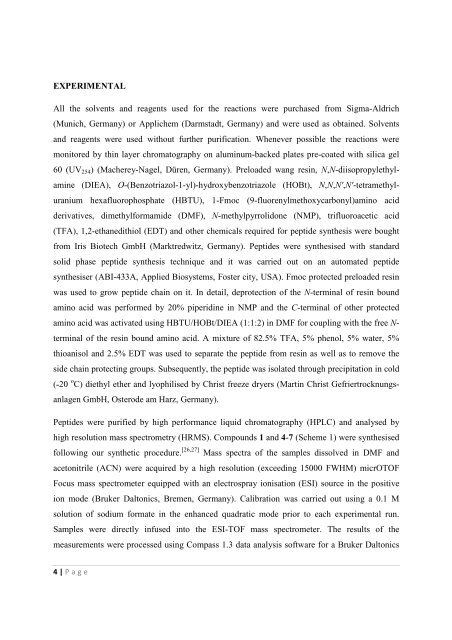The Development of Novel Antibiotics Using ... - Jacobs University
The Development of Novel Antibiotics Using ... - Jacobs University
The Development of Novel Antibiotics Using ... - Jacobs University
Create successful ePaper yourself
Turn your PDF publications into a flip-book with our unique Google optimized e-Paper software.
EXPERIMENTAL<br />
All the solvents and reagents used for the reactions were purchased from Sigma-Aldrich<br />
(Munich, Germany) or Applichem (Darmstadt, Germany) and were used as obtained. Solvents<br />
and reagents were used without further purification. Whenever possible the reactions were<br />
monitored by thin layer chromatography on aluminum-backed plates pre-coated with silica gel<br />
60 (UV 254 ) (Macherey-Nagel, Düren, Germany). Preloaded wang resin, N,N-diisopropylethylamine<br />
(DIEA), O-(Benzotriazol-1-yl)-hydroxybenzotriazole (HOBt), N,N,N',N'-tetramethyluranium<br />
hexafluorophosphate (HBTU), 1-Fmoc (9-fluorenylmethoxycarbonyl)amino acid<br />
derivatives, dimethylformamide (DMF), N-methylpyrrolidone (NMP), trifluoroacetic acid<br />
(TFA), 1,2-ethanedithiol (EDT) and other chemicals required for peptide synthesis were bought<br />
from Iris Biotech GmbH (Marktredwitz, Germany). Peptides were synthesised with standard<br />
solid phase peptide synthesis technique and it was carried out on an automated peptide<br />
synthesiser (ABI-433A, Applied Biosystems, Foster city, USA). Fmoc protected preloaded resin<br />
was used to grow peptide chain on it. In detail, deprotection <strong>of</strong> the N-terminal <strong>of</strong> resin bound<br />
amino acid was performed by 20% piperidine in NMP and the C-terminal <strong>of</strong> other protected<br />
amino acid was activated using HBTU/HOBt/DIEA (1:1:2) in DMF for coupling with the free N-<br />
terminal <strong>of</strong> the resin bound amino acid. A mixture <strong>of</strong> 82.5% TFA, 5% phenol, 5% water, 5%<br />
thioanisol and 2.5% EDT was used to separate the peptide from resin as well as to remove the<br />
side chain protecting groups. Subsequently, the peptide was isolated through precipitation in cold<br />
(˗20 o C) diethyl ether and lyophilised by Christ freeze dryers (Martin Christ Gefriertrocknungsanlagen<br />
GmbH, Osterode am Harz, Germany).<br />
Peptides were purified by high performance liquid chromatography (HPLC) and analysed by<br />
high resolution mass spectrometry (HRMS). Compounds 1 and 4-7 (Scheme 1) were synthesised<br />
following our synthetic procedure. [26,27] Mass spectra <strong>of</strong> the samples dissolved in DMF and<br />
acetonitrile (ACN) were acquired by a high resolution (exceeding 15000 FWHM) micrOTOF<br />
Focus mass spectrometer equipped with an electrospray ionisation (ESI) source in the positive<br />
ion mode (Bruker Daltonics, Bremen, Germany). Calibration was carried out using a 0.1 M<br />
solution <strong>of</strong> sodium formate in the enhanced quadratic mode prior to each experimental run.<br />
Samples were directly infused into the ESI-TOF mass spectrometer. <strong>The</strong> results <strong>of</strong> the<br />
measurements were processed using Compass 1.3 data analysis s<strong>of</strong>tware for a Bruker Daltonics<br />
4 | P a g e

















